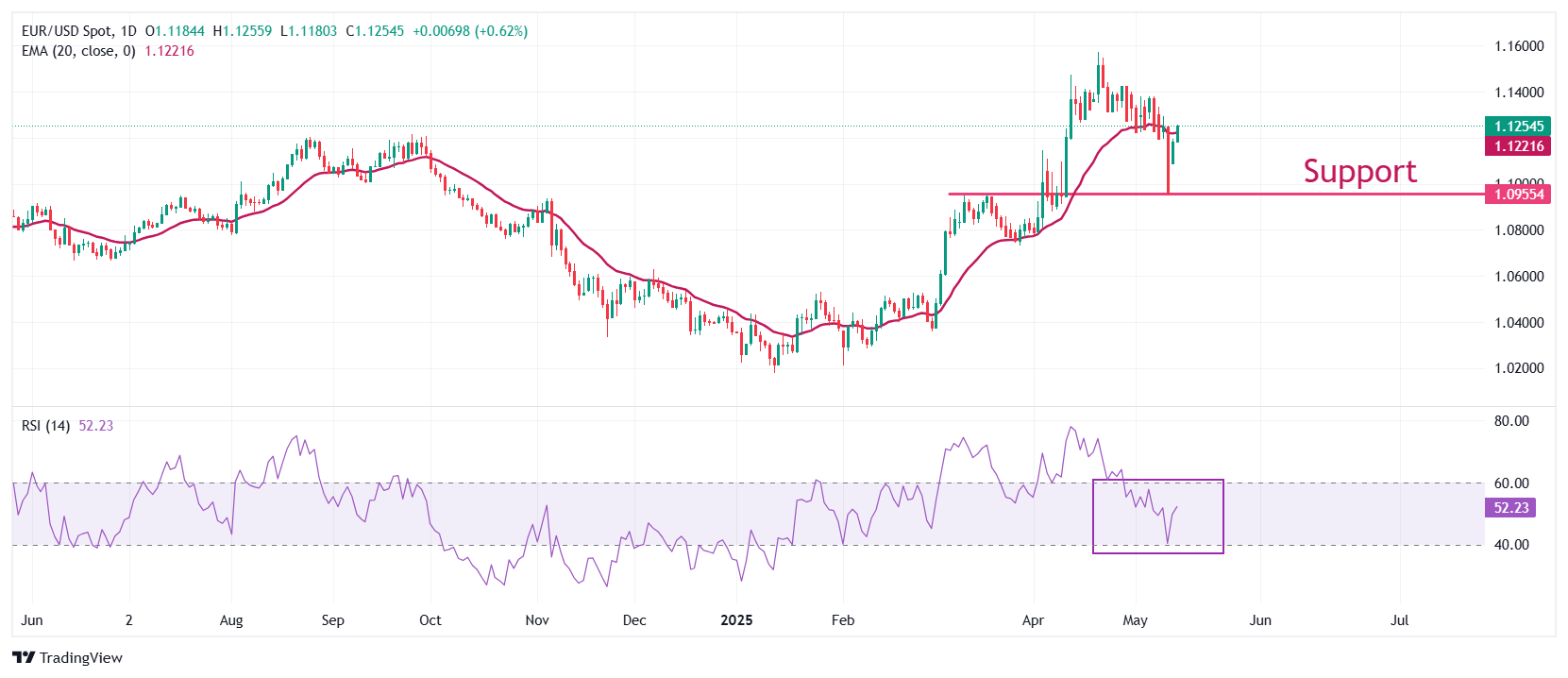EUR/USD extends recovery as soft US inflation data keeps US Dollar on backfoot
- EUR/USD recovers further to near 1.1250 as the US Dollar suffers after the release of the soft US inflation data for April.
- US President Trump criticized Fed Powell again for not lowering interest rates.
- ECB Villeroy says he is hopeful of another interest-rate cut before the summer ends.
EUR/USD moves higher to near 1.1250 during European trading hours on Wednesday, extending Tuesday’s gains. The major currency pair has attracted significant bids at the expense of the US Dollar (USD), with the US Dollar Index (DXY) – which gauges the Greenback’s value against six major currencies – extending its retracement from the monthly high of 102.00 to around 100.50.
The Greenback suffers as United States (US) President Donald Trump criticized the Federal Reserve (Fed) again for not lowering interest rates after the release of the softer-than-expected Consumer Price Index (CPI) data for April on Tuesday. The data showed that the headline CPI rose by 2.3%, the lowest level in over four years.
"No Inflation, and Prices of Gasoline, Energy, Groceries, and practically everything else, are DOWN!!! THE FED must lower the RATE, like Europe and China have done," Trump said in a post on Truth Social and added: "What is wrong with Too Late Powell? Not fair to America, which is ready to blossom? Just let it all happen, it will be a beautiful thing!”.
Despite slowing inflationary pressures and calls for interest rate cuts from US President Trump, traders have not pared bets supporting the Fed to cut borrowing rates before the September policy meeting. According to the CME FedWatch tool, the probability of the Fed keeping interest rates steady in the range of 4.25%-4.50% in July is marginally down to 63.3% from 65.1% seen on Tuesday.
It seems that an improvement in the US economic outlook due to the agreement with China for a temporary trade truce has absorbed the impact of cooling inflationary pressures. On Monday, the US and China agreed to avert a full-blown trade war and lowered tariffs by 115 percentage points.
Daily digest market movers: EUR/USD gains as Euro outperforms despite solid ECB dovish bets
- EUR/USD gains significantly due to a sharp correction in the US Dollar. The Euro (EUR) trades higher against its peers, except the Japanese Yen (JPY), on Wednesday. The major currency performs strongly even though European Central Bank (ECB) officials continue to stress the need to reduce interest rates further amid increasing confidence that US tariff policies will not increase Eurozone inflation. Theoretically, lower interest rates by the ECB bode poorly for the Euro.
- “We don’t see inflation picking up. The Trump administration’s protectionism will lead to a restart of inflation in the US, but not in Europe, which will likely allow for another rate cut by the summer,” ECB policymaker and Governor of the Bank of France Francois Villeroy de Galhau said, Reuters reported.
- Meanwhile, investors seek fresh cues on the progress of trade talks between the US and the European Union (EU). Investors have become anxious due to an absence of commentary from the White House about any progress in trade talks with the trading bloc, assuming sluggish efforts from the European Commission (EC) in resolving trade issues.
- This week, the major trigger for the shared currency pair will be the speech from Fed Chair Powell at the Thomas Laubach Research Conference in Washington on Thursday. Fed Powell is expected to provide fresh guidance on the monetary policy outlook in the wake of a temporary truce between the US and China.
- On the economic front, investors will focus on the Retail Sales and the Producer Price Index (PPI) data for April, which will be released on Thursday.
Technical Analysis: EUR/USD recovers to near 1.1250

EUR/USD extends its recovery to near 1.1250 on Wednesday. The pair bounces back strongly and recovers above the 20-day Exponential Moving Average (EMA), which trades around 1.1220, suggesting that the trend has turned bullish.
The 14-period Relative Strength Index (RSI) recovers strongly from 40.00, suggesting that bullish bias is intact.
Looking up, the April 28 high of 1.1425 will be the major resistance for the pair. Conversely, the March 11 high of 1.0950 will be a key support for the Euro bulls.
Euro FAQs
The Euro is the currency for the 19 European Union countries that belong to the Eurozone. It is the second most heavily traded currency in the world behind the US Dollar. In 2022, it accounted for 31% of all foreign exchange transactions, with an average daily turnover of over $2.2 trillion a day. EUR/USD is the most heavily traded currency pair in the world, accounting for an estimated 30% off all transactions, followed by EUR/JPY (4%), EUR/GBP (3%) and EUR/AUD (2%).
The European Central Bank (ECB) in Frankfurt, Germany, is the reserve bank for the Eurozone. The ECB sets interest rates and manages monetary policy. The ECB’s primary mandate is to maintain price stability, which means either controlling inflation or stimulating growth. Its primary tool is the raising or lowering of interest rates. Relatively high interest rates – or the expectation of higher rates – will usually benefit the Euro and vice versa. The ECB Governing Council makes monetary policy decisions at meetings held eight times a year. Decisions are made by heads of the Eurozone national banks and six permanent members, including the President of the ECB, Christine Lagarde.
Eurozone inflation data, measured by the Harmonized Index of Consumer Prices (HICP), is an important econometric for the Euro. If inflation rises more than expected, especially if above the ECB’s 2% target, it obliges the ECB to raise interest rates to bring it back under control. Relatively high interest rates compared to its counterparts will usually benefit the Euro, as it makes the region more attractive as a place for global investors to park their money.
Data releases gauge the health of the economy and can impact on the Euro. Indicators such as GDP, Manufacturing and Services PMIs, employment, and consumer sentiment surveys can all influence the direction of the single currency. A strong economy is good for the Euro. Not only does it attract more foreign investment but it may encourage the ECB to put up interest rates, which will directly strengthen the Euro. Otherwise, if economic data is weak, the Euro is likely to fall. Economic data for the four largest economies in the euro area (Germany, France, Italy and Spain) are especially significant, as they account for 75% of the Eurozone’s economy.
Another significant data release for the Euro is the Trade Balance. This indicator measures the difference between what a country earns from its exports and what it spends on imports over a given period. If a country produces highly sought after exports then its currency will gain in value purely from the extra demand created from foreign buyers seeking to purchase these goods. Therefore, a positive net Trade Balance strengthens a currency and vice versa for a negative balance.

